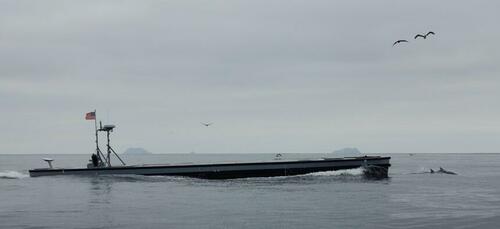The United States Marine Corps is currently testing a new class of low-profile, unmanned vessels inspired by the designs used by Latin American drug traffickers. These vessels, known as the Autonomous Low-Profile Vessel (ALPV), are being developed with a focus on potential use in the Indo-Pacific region, particularly in scenarios that may involve conflict with China.
The specific model under examination is the “Sea Specter,” manufactured by Gibbs & Cox, a subsidiary of Leidos, based in Reston, Virginia. According to Jeff Bowles, Chief Engineering Officer at Gibbs & Cox, while the concept draws inspiration from “narco subs,” the similarities largely end there. He emphasized that these vessels are designed with engineering precision, contrasting them with the often makeshift nature of actual narco subs. “In principle, their mission is the same—move a large volume of cargo with the minimal chance of being observed by anyone else,” Bowles stated in an interview with Defense One.
The need for such innovative vessels arises from a shift in military focus. Historically, US operations have concentrated on counterinsurgency against adversaries lacking the capability to challenge logistical supply lines through air or sea. However, in the event of a potential conflict with China, American assets may face greater vulnerabilities. Bowles highlights the importance of using less detectable, smaller vessels to transport supplies without revealing troop positions.
The Sea Specter measures approximately 65 feet in length, with an above-water profile that varies from a few feet to mere inches. It is equipped with a command and control system developed by Sea Machines Robotics. With a sensor mounted eight feet above the deck, the ALPV has a visibility range of 5 to 7 miles, allowing it to carry up to 5 tons over a distance of 2,300 nautical miles at a speed of 8 knots. For context, this range is significant; it covers the distance from Guam to the Philippines, which is roughly 1,500 miles.
Bowles suggests that during wartime, the Marines could deploy multiple Sea Specters for logistical missions, potentially sacrificing some to enemy defenses. “You might want to send a dozen narco subs on such a supply run, allowing for half of them to be blown up by China,” he remarked, highlighting the tactical considerations involved.
While the primary focus of the ALPV program is on logistics, the Sea Specter could serve multiple roles. Bowles mentioned its potential to remain in a designated area for extended periods, which could facilitate communication or establish a monitoring presence against intrusions. “These things have the endurance to sit there,” he noted, further suggesting their applicability in monitoring activities such as human trafficking.
Currently, the Sea Specter is constructed from wood, a temporary solution according to Bowles. He indicated that future iterations would likely transition to materials such as fiberglass, aluminum, or steel to enhance durability and production efficiency.
The military’s exploration of robotic supply vessels raises broader discussions about the evolution of warfare. As nations advance in robotics, concerns are emerging regarding the potential for autonomous systems to replace human soldiers, leading to scenarios reminiscent of science fiction narratives.
The development of the Sea Specter and similar technologies marks a significant step for the United States Marine Corps as it prepares for the complexities of modern warfare in the Indo-Pacific theater. With evolving threats and the necessity for stealthy logistical operations, these innovations could play a vital role in future military strategy.
